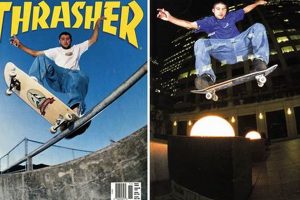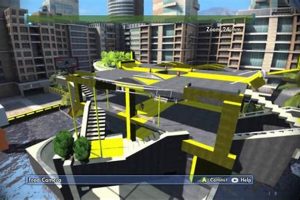The process of manually refining the blade edges of ice skates to restore their sharpness is a specialized skill requiring precision and patience. This technique involves using a series of sharpening stones and tools to carefully hone the steel, creating or maintaining a defined edge critical for optimal performance on the ice. Improper execution can diminish blade integrity.
Maintaining sharp edges on ice skates is paramount for skaters of all levels, enhancing control, improving glide, and reducing the effort required for maneuvers. Historically, skate sharpening was a ubiquitous skill within skating communities, passed down through generations. While mechanized sharpening has become prevalent, the manual approach offers a nuanced level of control and customization, allowing for fine-tuning based on individual skating style and preferences. This approach also contributes to blade longevity if done correctly.
Therefore, an understanding of the necessary equipment, the techniques involved, and the indicators of a properly sharpened blade are essential for those seeking to maintain their skates manually. Detailed instructions will now be provided concerning the tools, the steps, and the quality control methods associated with achieving a professional result.
Essential Considerations for Manual Skate Sharpening
The following guidelines are provided to enhance the precision and effectiveness of manual skate sharpening techniques. Adherence to these recommendations can minimize the risk of blade damage and optimize performance.
Tip 1: Select the Appropriate Stone Grit: Employ a coarse grit stone initially to address significant imperfections or damage to the blade edge. Subsequently, transition to finer grit stones for refining and polishing the edge to the desired sharpness.
Tip 2: Maintain a Consistent Angle: Throughout the sharpening process, ensure the skate blade is held at a consistent angle relative to the sharpening stone. Fluctuations in angle can lead to uneven edges and compromised performance.
Tip 3: Apply Even Pressure: Distribute pressure evenly along the length of the blade during each pass. Uneven pressure can result in localized over-sharpening or under-sharpening, affecting the blade’s overall balance.
Tip 4: Regularly Clean the Sharpening Stones: Accumulation of metal filings on the sharpening stones can impede their effectiveness. Utilize a cleaning stone or appropriate solvent to remove debris and maintain optimal cutting performance.
Tip 5: Check Blade Flatness Frequently: Use a flat edge (such as a steel ruler) to check the blade’s flatness to avoid unintended rocking. The blade must be perfectly flat. Imperfections will hinder performance. Take corrective action as needed before beginning the sharpening process.
Tip 6: Deburr the Blade After Sharpening: Following the sharpening process, meticulously remove any burrs or fine metal shavings from the blade edges using a deburring tool. Failure to remove burrs can cause drag and reduce glide efficiency.
Tip 7: Use a Honing Compound: Apply honing compound to the final stone during the finishing stages of the sharpening process. Honing compound aids in achieving an ultra-fine edge and enhances the blade’s overall sharpness.
Consistent application of these techniques will yield improved control, greater efficiency, and enhanced performance on the ice.
The subsequent sections will delve into advanced techniques and maintenance procedures to further refine the art of skate sharpening.
1. Stone Grit Selection
The selection of appropriate stone grit is a foundational element in the manual skate sharpening process. The grit number, an inverse indicator of particle size, dictates the rate of material removal and the resulting finish on the skate blade. Incorrect grit selection can lead to inefficiency, blade damage, or suboptimal performance.
- Coarse Grit Stones (e.g., 200-400 grit)
Coarse grit stones are employed primarily for addressing significant damage, such as nicks, burrs, or substantial unevenness along the blade edge. Their aggressive cutting action quickly removes material, reshaping the blade profile. However, excessive use of coarse grits can result in an overly aggressive edge and should be followed by finer grits to refine the finish.
- Medium Grit Stones (e.g., 600-800 grit)
Medium grit stones serve as the bridge between coarse and fine grits, smoothing the blade surface and refining the edge created by the coarser stone. This stage removes scratches and prepares the blade for final polishing. Consistent application of a medium grit ensures a uniform surface for the subsequent fine grit.
- Fine Grit Stones (e.g., 1000-1200 grit)
Fine grit stones are crucial for achieving a sharp, polished edge, essential for optimal glide and control on the ice. These stones remove microscopic imperfections, resulting in a highly refined edge. Repeated use of fine grits can maintain sharpness between more intensive sharpening sessions. The degree of polish can also affect edge “bite”, or the ability to grip the ice.
- Ultra-Fine Grit Stones (e.g., 3000+ grit) and Honing Steels
Ultra-fine grit stones and honing steels are employed to produce a near-mirror finish on the blade edge. These are often used in conjunction with honing compounds. This level of refinement is particularly valued by competitive skaters who require maximum glide and responsiveness. However, it’s important to note that excessively polished edges may sacrifice some bite, necessitating a careful balance.
In summary, strategic stone grit selection during manual skate sharpening directly impacts the final blade profile and performance characteristics. A systematic progression from coarse to fine grits is crucial for achieving a sharp, durable, and predictable edge, enabling skaters to maximize their potential on the ice.
2. Consistent Angle Maintenance
Consistent angle maintenance is a critical component within the manual skate sharpening process. The angle at which the skate blade is presented to the sharpening stone directly influences the resulting edge profile and, consequently, the skate’s performance on the ice. Deviation from a consistent angle leads to asymmetry in the blade edges, affecting balance, glide, and the skater’s ability to execute precise maneuvers. For example, if the inside edge is sharpened at a steeper angle than the outside edge, the skater will experience a tendency to turn in that direction, hindering straight-line speed and controlled turns.
The practical significance of consistent angle maintenance lies in its ability to create two edges of equal sharpness and profile. These balanced edges are crucial for maintaining stability and control during skating. This principle directly translates to enhanced agility, improved edge control for advanced maneuvers, and reduced fatigue, as the skater is not constantly compensating for an uneven blade profile. Professional skate sharpeners often employ jigs or guides to ensure a repeatable angle is maintained throughout the sharpening process, thus minimizing human error. Real-world examples include competitive figure skaters who demand perfectly symmetrical edges for executing complex jumps and spins; any asymmetry would compromise their routine.
In summary, the consistent application of a specific angle between the skate blade and sharpening stone is paramount to achieving a balanced and effective edge. Challenges in angle maintenance often arise from freehand sharpening techniques, highlighting the importance of specialized tools or rigorous practice to develop the necessary skill. Proper angle maintenance is not merely a detail; it is an integral aspect of manual skate sharpening, directly impacting a skater’s performance and overall experience on the ice. Understanding this connection underscores the need for precision and careful attention to detail when manually sharpening skates.
3. Even Pressure Application
Uneven pressure application during manual skate sharpening directly correlates with inconsistent edge geometry and diminished performance. The principle of even pressure dictates that force exerted against the blade during contact with the sharpening stone must be uniformly distributed along the entire length of the edge. Deviations from this principle result in localized variations in material removal, leading to inconsistencies in edge sharpness and angle. For example, applying greater pressure near the heel or toe of the blade will create a sharper edge in those areas, while the mid-section remains comparatively dull. This asymmetry compromises glide efficiency, turning stability, and overall control on the ice.
The practical significance of understanding and implementing even pressure lies in the ability to achieve a predictable and consistent blade profile. This, in turn, facilitates smoother glides, more controlled turns, and reduced energy expenditure for the skater. Specifically, consider a hockey player executing a sharp turn; uneven edges will cause the skate to “bite” into the ice unevenly, potentially leading to a loss of balance and reduced agility. Similarly, a figure skater attempting a complex jump requires perfectly balanced edges for a controlled landing; uneven pressure during sharpening can create subtle asymmetries that disrupt the jump’s trajectory. Achieving even pressure is often facilitated by using a consistent stroke, maintaining proper body posture, and periodically checking the blade profile with a straight edge.
In summary, the application of even pressure is not merely a procedural step; it is a foundational element contributing to the overall quality and performance of manually sharpened ice skates. While challenges in mastering this technique may arise from variations in hand strength, sharpening stone condition, and blade irregularities, recognizing its importance and employing consistent technique are crucial for maximizing a skater’s performance. The ability to consistently apply even pressure distinguishes skilled sharpeners and directly contributes to the effectiveness of the manual sharpening process.
4. Stone Cleanliness
Stone cleanliness is a critical, often overlooked, aspect of manual skate blade maintenance. Residue buildup on sharpening stones compromises their abrasive efficiency, hindering the ability to achieve a sharp and consistent edge. A contaminated stone essentially polishes the blade rather than properly sharpening it, leading to suboptimal performance on the ice.
- Metal Swarf Accumulation
During the sharpening process, fine metal particles, known as swarf, are removed from the skate blade and accumulate on the surface of the sharpening stone. This buildup clogs the abrasive pores of the stone, reducing its cutting effectiveness. A stone saturated with swarf glides over the blade, burnishing it rather than creating a sharp edge. Regular cleaning, using a specialized cleaning stone or solvent, is essential to remove accumulated swarf and maintain the stone’s abrasive properties. Failure to do so will lead to an ineffective sharpening process, requiring more time and effort to achieve the desired result.
- Contaminant Transfer
Sharpening stones can also accumulate contaminants from the environment, such as dust, oil, and debris. These foreign substances impede the stone’s ability to make clean contact with the skate blade, further reducing its effectiveness. The transfer of these contaminants can also introduce unwanted scratches or imperfections to the blade. Storing stones in a clean, protected environment minimizes the risk of contamination. Prior to use, wiping the stone with a clean cloth removes loose debris, ensuring optimal performance.
- Glazing Effect
Over time, the continuous accumulation of metal swarf and other contaminants can lead to a “glazing” effect on the sharpening stone. This glazing manifests as a smooth, polished surface that lacks the necessary abrasiveness to properly sharpen the skate blade. Deglazing, using a specialized dressing stone, is necessary to expose fresh abrasive particles and restore the stone’s cutting efficiency. Regular deglazing is essential for maintaining the stone’s performance and extending its lifespan.
- Impact on Edge Quality
The cleanliness of the sharpening stone directly impacts the final edge quality of the skate blade. A clean stone produces a consistent, sharp edge with minimal imperfections. Conversely, a contaminated stone yields an uneven, dull edge that compromises glide efficiency and control on the ice. Maintaining stone cleanliness is, therefore, not merely a cosmetic concern; it is a fundamental requirement for achieving optimal skate blade performance and maximizing a skater’s capabilities.
In conclusion, consistent stone maintenance is inseparable from effectively refining ice skate blades manually. Addressing metal swarf accumulation, mitigating contaminant transfer, and reversing the glazing effect directly affect the achievable sharpness and consistency. Recognizing stone maintenance as an integral step within the broader process ensures optimal outcomes and longevity of the sharpening tools.
5. Blade Flatness Verification
Blade flatness verification is a foundational step preceding any attempt to manually refine ice skate blades. The integrity of the sharpening process relies on a true, un-warped blade surface. Absent this, efforts to create a consistent, sharp edge are fundamentally compromised, resulting in suboptimal performance and potentially unsafe skating conditions.
- Rockering Detection
Rockering refers to any deviation from a perfectly flat profile along the blade’s running surface. Such deviations, often subtle, can drastically affect the skate’s glide and turning characteristics. For instance, a blade that is high in the middle will exhibit diminished contact with the ice, reducing glide efficiency and making controlled turns difficult. Conversely, a blade that is low in the middle will “bite” aggressively, hindering smooth transitions and potentially leading to instability. Identifying and addressing rockering issues is essential prior to sharpening to ensure a uniform edge profile.
- Consistent Sharpening Angle
Maintaining a consistent sharpening angle is paramount during manual sharpening. However, this becomes virtually impossible if the blade itself is not flat. Warped or bowed blades force the sharpener to constantly adjust the angle, leading to an uneven edge and unpredictable performance. By verifying and correcting blade flatness beforehand, the sharpener can maintain a consistent angle throughout the process, resulting in a precisely honed edge.
- Longitudinal and Lateral Flatness
Flatness must be assessed in both the longitudinal (heel to toe) and lateral (side to side) dimensions. Longitudinal flatness ensures consistent contact along the blade’s length, while lateral flatness ensures equal edge sharpness on both the inside and outside edges. Lack of lateral flatness often results in one edge being sharper than the other, causing the skater to constantly compensate for the imbalance. Addressing both dimensions is critical for achieving a balanced and predictable skating experience.
- Impact on Blade Longevity
Attempting to sharpen a warped blade can accelerate wear and tear, potentially shortening the blade’s lifespan. Applying excessive pressure in certain areas to compensate for unevenness can lead to localized over-sharpening and material removal. Verifying and correcting blade flatness minimizes the need for such corrective actions, preserving the blade’s integrity and extending its usable life. This proactive approach contributes to long-term cost savings and ensures consistent performance.
In essence, blade flatness verification is not merely a preliminary check; it is a prerequisite for successful manual skate sharpening. Neglecting this step undermines the effectiveness of the subsequent sharpening process, ultimately impacting the skater’s performance and safety. Therefore, meticulous attention to blade flatness is integral to the art and science of manual skate maintenance.
6. Deburring Precision
Deburring precision is an indispensable facet of the manual skate sharpening process, directly impacting the blade’s performance and the skater’s experience on the ice. The meticulous removal of microscopic metal fragments, known as burrs, formed during sharpening, is essential for achieving a clean, smooth edge. These burrs, if left unaddressed, negatively affect glide, control, and overall skating efficiency.
- Burr Formation Mechanics
The act of sharpening inherently creates burrs. As the sharpening stone abrades the steel blade, microscopic fragments are displaced, forming a thin, fragile lip along the newly sharpened edge. This lip, or burr, is inherently unstable and interferes with the blade’s intended interaction with the ice. Effective deburring aims to remove this unstable structure without compromising the underlying sharpness of the edge.
- Deburring Tool Selection
Various tools are employed for deburring, each offering a specific approach and level of precision. Leather strops, fine-grit stones, and specialized deburring tools are common options. The choice of tool depends on the blade’s steel type, the sharpening technique used, and the desired level of refinement. The selected tool must effectively remove the burr without rounding over or dulling the sharpened edge.
- Impact on Glide Efficiency
Burrs significantly impede glide efficiency. The irregular surface created by the burr increases friction between the blade and the ice, requiring the skater to expend more energy to maintain speed and momentum. Precisely deburred blades glide more smoothly, allowing for effortless transitions and reduced fatigue. This effect is particularly noticeable during long skating sessions or competitive events.
- Influence on Edge Control
Burrs also negatively affect edge control. The unstable lip along the edge prevents consistent engagement with the ice, leading to unpredictable grip and compromised maneuverability. Skaters may experience a “slipping” sensation, particularly during sharp turns or intricate footwork. A precisely deburred blade provides a clean, reliable edge that allows for confident control and precise execution of skating techniques.
In summary, deburring precision directly influences the outcome of manual skate sharpening. The careful selection of deburring tools and the meticulous execution of the deburring process translate to improved glide efficiency, enhanced edge control, and a more enjoyable skating experience. Skilled manual skate sharpening necessitates not only creating a sharp edge but also ensuring that this edge is clean, smooth, and free from any performance-hindering burrs.
7. Honing Compound Usage
Honing compound usage represents a critical refinement stage within manual skate sharpening, directly influencing the final edge quality and performance characteristics. The application of honing compounds, typically fine abrasive pastes or liquids, serves to polish the blade edge beyond what is achievable with sharpening stones alone. This action removes microscopic imperfections and burrs that may remain after sharpening, producing an exceptionally keen and smooth edge. Neglecting this step will result in a blade that, while sharp, lacks the optimal gliding properties conferred by a highly polished surface.
The practical significance of honing compound usage lies in its ability to minimize friction between the skate blade and the ice. A polished edge reduces resistance, allowing the skater to glide more efficiently and maintain speed with less effort. In competitive disciplines, such as figure skating and speed skating, this subtle improvement in glide efficiency can translate into significant performance gains. Furthermore, the removal of micro-burrs through honing improves edge control, enabling more precise turns and enhanced maneuverability. For instance, a figure skater executing a complex jump relies on a clean, burr-free edge to maintain stability and control during the landing. The utilization of honing compound, therefore, is not merely a cosmetic enhancement but a functional necessity for achieving peak performance.
In conclusion, honing compound usage is an integral component of a comprehensive manual skate sharpening process. It contributes significantly to the final edge quality, glide efficiency, and edge control, directly impacting the skater’s experience and performance. While proper honing technique requires practice and attention to detail, the benefits derived from this refinement stage justify the effort involved. Recognizing and implementing this stage elevates manual skate sharpening from a basic maintenance task to a precision art, ensuring optimal blade performance and maximizing the skater’s potential.
Frequently Asked Questions
The following frequently asked questions address common concerns and misconceptions regarding manual skate sharpening techniques, emphasizing best practices for achieving optimal results.
Question 1: How frequently should ice skates be manually sharpened?
The frequency depends on several factors, including skating frequency, ice conditions, and skating style. Generally, sharpening is required when a noticeable decrease in edge grip occurs. Visual inspection of the blade edge for damage can also indicate the need for sharpening.
Question 2: What are the primary indicators of a dull skate blade?
Indicators include a lack of “bite” when attempting turns, increased effort required for maintaining speed, and a general feeling of instability on the ice. A visual inspection may reveal rounded or damaged edges.
Question 3: Is manual skate sharpening superior to machine sharpening?
Neither method is inherently superior. Manual sharpening offers greater control and customization, allowing for nuanced adjustments to the blade profile. Machine sharpening provides speed and consistency but may lack the fine-tuning capabilities of manual methods. The optimal choice depends on individual preferences and skill level.
Question 4: What types of sharpening stones are recommended for manual skate sharpening?
A progression of stones with varying grit levels is typically employed. A coarse stone is used for initial shaping and damage repair, followed by medium and fine stones for refining the edge. A final polishing with a honing compound is often recommended.
Question 5: Can manual skate sharpening damage the blade?
Yes, improper technique can damage the blade. Excessive pressure, inconsistent angles, and the use of excessively coarse stones can lead to irreversible damage. Proper training and careful technique are essential for minimizing risk.
Question 6: Is professional training necessary for manual skate sharpening?
While not strictly necessary, professional training is highly recommended. Experienced instructors can provide valuable guidance on proper technique, stone selection, and safety precautions. This training significantly reduces the risk of blade damage and improves the quality of the sharpening.
Consistent application of proper techniques is crucial for achieving optimal results in manual skate sharpening. Prioritizing precision and understanding the principles involved will contribute to improved performance and enhanced enjoyment of skating.
The following section will provide a concluding summary and recommendations for further learning in the field of manual skate sharpening.
Conclusion
This exploration of how to hand sharpen skates has detailed essential aspects of the process, from stone selection to honing compound application. The importance of consistent angle maintenance, even pressure, and blade flatness verification has been emphasized. These elements collectively contribute to a sharper, more consistent edge, enhancing a skaters performance.
Mastery of manual skate sharpening requires dedication and meticulous attention to detail. Consistent practice and a commitment to understanding the nuanced techniques described herein are essential for achieving professional-quality results. The pursuit of this skill not only provides greater control over skate maintenance but also cultivates a deeper appreciation for the art and science of blade preparation.







